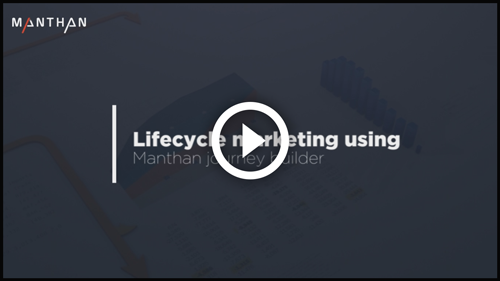Plenty has been said about Journey Marketing and it is at the top of the list while evaluating marketing technology today. Rightly so. In a crowded retail landscape, customers have access to options and information from the comfort of their home, and just one below average touchpoint is enough to lose them. Aligning marketing to the customer journey is no more a luxury.
Journey marketing brings a fundamental shift in the way marketers reach out to customers. Marketers use their understanding of the customer, their possible lifecycle stage and purchase paths to create a valuable experience for the customer.

Watch a 2 minute video of how journeys can be configured in Manthan Customer Marketing Platform
This requires work, but let me demystify the process. Here is a step-by-step approach to define and implement customer journey targeting:
1. Create a customer journey map and identify gaps
This should be the starting point for the marketer. A journey map outlines customer’s interactions and experience with the brand across channels over time. It is obvious that this map should reflect the customer’s point of view – for this, step into the customer’s shoes, and don’t be tainted by the brand’s internal process view.
An as-is journey map and an ideal state map should be created. The gap is what journey marketing should help bridge.
2. Set goals for journey stages
Conversion is what all businesses chase, however, this internal goal needs to be translated to customer expectations. As a customer moves across stages, her need for content and information changes. For example, after she has selected the dress, she is looking for the return policy and shipping information.
Brand’s inability to serve contextual content across each stage of the journey will result in losing the sale, and a reduced chance of the customer re-visiting you. Marketers need to define what a customer would expect from each stage, rather than pushing conversions.
3. Each customer is different
This is table stakes for targeted marketing and remains true for journey marketing. Define customer personas and personalize communications based on their preferences. Often, marketing is limited to single dimensional personas, ignoring vast amounts of contextual and interaction information available to a business. Almost all martech vendors today claim to be multi-channel, but in reality, limit marketers with fixed single dimension segments. Omnichannel marketers should make use of all possible data, cluster it across multiple dimensions and create micro-segments to truly understand and engage customers.
4. Automate
Once customer journey maps, lifecycle stages, and personas are defined, marketing is ready to set up automated repeatable campaigns. This converts single-step, single-channel campaigns into multi-step, multi-channel campaigns. Journeys are dynamic, and automation should be able to account for different scenarios. For example, journeys should be able to trigger actions such as changing channels to elicit a better response.
5. Measure
Next, marketers should have the tools to track performance against business goals established for each journey, for example, journeys might have been designed to drive customer engagement, move customers to the next stage or to drive sales conversion. Results from measurement should enable marketers to clearly identify journeys that are effective in driving goals.
6. Optimize
Using data from past performance, and supplementing it up with Machine Learning algorithms can then identify best channels and best offers for a customer. Like anywhere else, personalizing for each segment is the key to maximize engagement, and account for different behaviors. Journeys that embed test & control and A/B testing capabilities are an excellent way to scientifically select the best variation and creatives, and truly understand the effectiveness.








 More Resources
More Resources 
